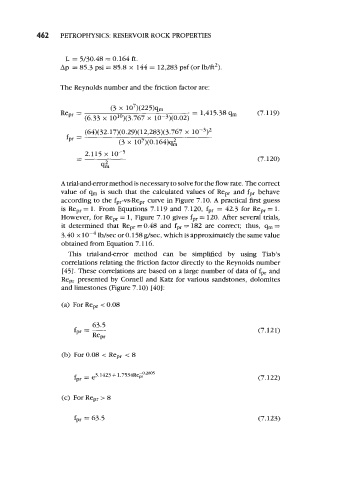Page 494 - Petrophysics
P. 494
462 PETROPHYSICS: RESERVOIR ROCK PROPERTIES
L = 5/30.48 = 0.164 ft.
Ap = 85.3 psi = 85.8 x 144 = 12,283 psf (or lb/ft2).
The Reynolds number and the friction factor are:
(3 x 107)(225)qm
Repr = = 1,415.38 qm (7.119)
(6.33 x 1O1')(3.767 x lO-3)(O.O2)
(64)(32.17)(0.29)(12,283)(3.767 10-3)2
X
fpr = (3 x 1O7)(O.164)q&
2.115 x
- (7.120)
-
2
qm
A trial-and-error method is necessary to solve for the flow rate. The correct
value of qm is such that the calculated values of Re,, and fpr behave
according to the fpr-vS-Rep, curve in Figure 7.10. A practical first guess
is Re,, = 1. From Equations 7.119 and 7.120, fpr = 42.3 for Repr = 1.
However, for Re,, = 1, Figure 7.10 gives fpr = 120. After several trials,
it determined that Repr = 0.48 and fpr = 182 are correct; thus, qm =
3.40 x lo-* Ib/sec or 0.158 g/sec, which is approximately the same value
obtained from Equation 7.116.
This trial-and-error method can be simplified by using Tiab's
correlations relating the friction factor directly to the Reynolds number
[45]. These correlations are based on a large number of data of fpr and
Rep presented by Cornell and Katz for various sandstones, dolomites
and limestones (Figure 7.10) [40]:
(a) For Repr < 0.08
(7.121)
(b) For 0.08 < Repr < 8
fpr = e 3.1423 + 1.7534Re~~2805
(7.122)
(c) For Repr > 8
fpr = 63.5 (7.123)

